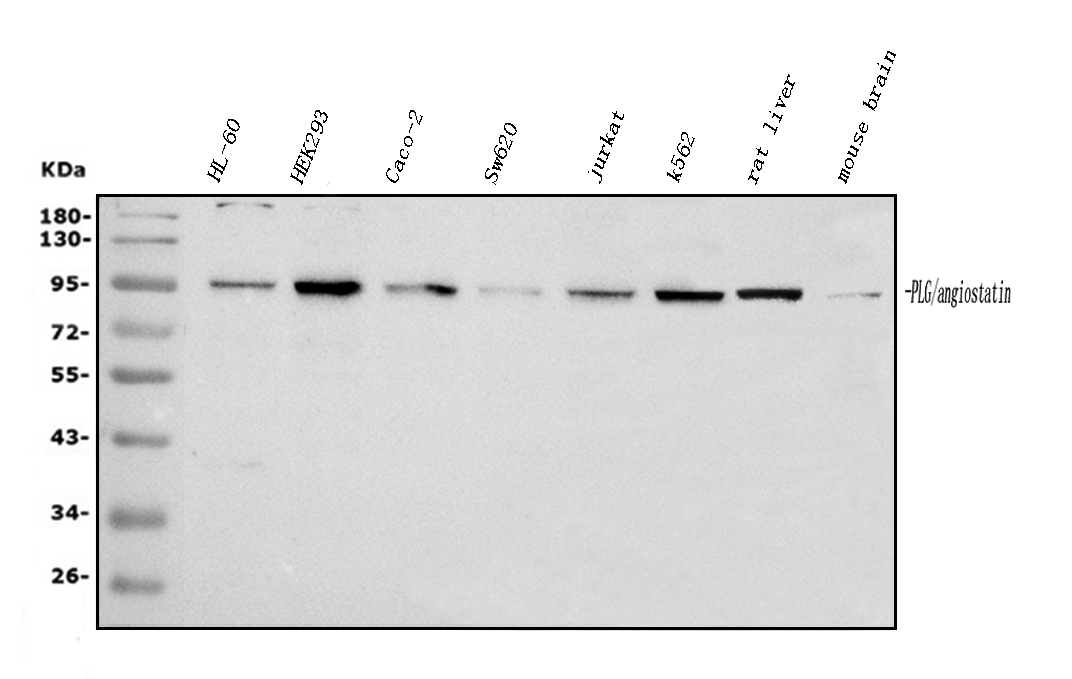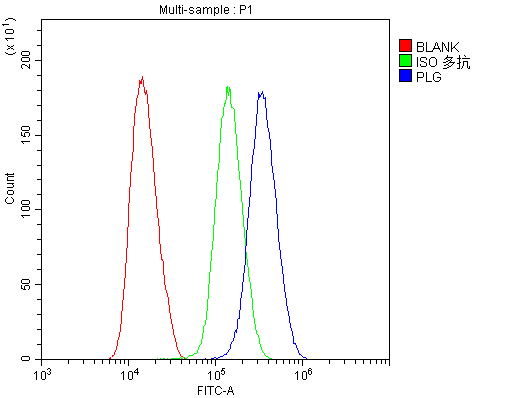| Western blot (WB): | 1:500-2000 |
| Flow Cytometry (Fixed): | 1:50-200 |

Western blot analysis of Plasminogen/PLG using anti-Plasminogen/PLG antibody (A03674-1). The sample well of each lane was loaded with 30 ug of sample under reducing conditions.
Lane 1: human placenta tissue lysates,
Lane 2: human HL-60 whole cell lysates,
Lane 3: human 22RV1 whole cell lysates,
Lane 4: human 293T tissue lysates,
Lane 5: human PANC-1 whole cell lysates,
Lane 6: human SGC-7901 whole cell lysates,
Lane 7: human Caco-2 whole cell lysates,
Lane 8: human PC-3 whole cell lysates,
Lane 9: rat brain tissue lysates,
Lane 10: mouse brain tissue lysates.
After electrophoresis, proteins were transferred to a membrane. Then the membrane was incubated with rabbit anti-Plasminogen/PLG antigen affinity purified polyclonal antibody (A03674-1) at a dilution of 1:1000 and probed with a goat anti-rabbit IgG-HRP secondary antibody (Catalog # BA1054). The signal is developed using ECL Plus Western Blotting Substrate (Catalog # AR1197). A specific band was detected for Plasminogen/PLG at approximately 90 kDa. The expected band size for Plasminogen/PLG is at 91 kDa.

Flow Cytometry analysis of U251 cells using anti-Plasminogen/PLG antibody (A03674-1).
Overlay histogram showing U251 cells stained with A03674-1 (Blue line). To facilitate intracellular staining, cells were fixed with 4% paraformaldehyde and permeabilized with permeabilization buffer. The cells were blocked with 10% normal goat serum. And then incubated with rabbit anti-Plasminogen/PLG Antibody (A03674-1) at 1:100 dilution for 30 min at 20°C. DyLight®488 conjugated goat anti-rabbit IgG (BA1127) was used as secondary antibody at 1:100 dilution for 30 minutes at 20°C. Isotype control antibody (Green line) was rabbit IgG at 1:100 dilution used under the same conditions. Unlabelled sample without incubation with primary antibody and secondary antibody (Red line) was used as a blank control.

Western blot analysis of Plasminogen/PLG using anti-Plasminogen/PLG antibody (A03674-1). The sample well of each lane was loaded with 30 ug of sample under reducing conditions.
Lane 1: human placenta tissue lysates,
Lane 2: human HL-60 whole cell lysates,
Lane 3: human 22RV1 whole cell lysates,
Lane 4: human 293T tissue lysates,
Lane 5: human PANC-1 whole cell lysates,
Lane 6: human SGC-7901 whole cell lysates,
Lane 7: human Caco-2 whole cell lysates,
Lane 8: human PC-3 whole cell lysates,
Lane 9: rat brain tissue lysates,
Lane 10: mouse brain tissue lysates.
After electrophoresis, proteins were transferred to a membrane. Then the membrane was incubated with rabbit anti-Plasminogen/PLG antigen affinity purified polyclonal antibody (A03674-1) at a dilution of 1:1000 and probed with a goat anti-rabbit IgG-HRP secondary antibody (Catalog # BA1054). The signal is developed using ECL Plus Western Blotting Substrate (Catalog # AR1197). A specific band was detected for Plasminogen/PLG at approximately 90 kDa. The expected band size for Plasminogen/PLG is at 91 kDa.

Flow Cytometry analysis of U251 cells using anti-Plasminogen/PLG antibody (A03674-1).
Overlay histogram showing U251 cells stained with A03674-1 (Blue line). To facilitate intracellular staining, cells were fixed with 4% paraformaldehyde and permeabilized with permeabilization buffer. The cells were blocked with 10% normal goat serum. And then incubated with rabbit anti-Plasminogen/PLG Antibody (A03674-1) at 1:100 dilution for 30 min at 20°C. DyLight®488 conjugated goat anti-rabbit IgG (BA1127) was used as secondary antibody at 1:100 dilution for 30 minutes at 20°C. Isotype control antibody (Green line) was rabbit IgG at 1:100 dilution used under the same conditions. Unlabelled sample without incubation with primary antibody and secondary antibody (Red line) was used as a blank control.

